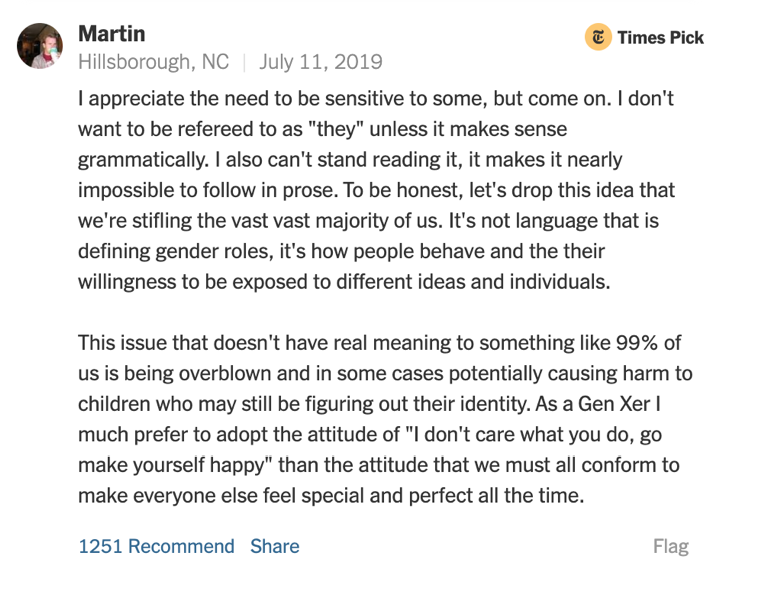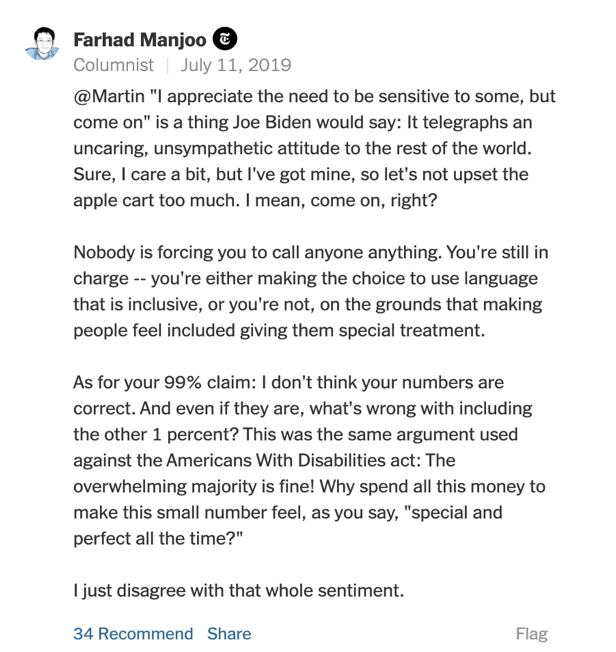22 Converse
Robert Sternberg
To converse with a source, you first need to “listen” to what it has to say; after that, it’s time to “respond.”
What You’ll Learn:
- How to listen to your source
- How to formulate a response

Partial Understanding

Full Understanding
In the photographs above, we can observe the difference between a partial and a full understanding. It’s ideal to acquire a full understanding of a text before we respond to it.
Listening
Exercise A: Reading to Understand
Take a look at the following three claims and determine whether or not the author made them. If Manjoo made the claim, answer “true”; if Manjoo didn’t, answer “false.”
On July 10, 2019, The New York Times opinion columnist Farhad Manjoo wrote an article titled “It’s Time for ‘They.’” Its main argument? “The singular ‘they’ is inclusive and flexible, and it breaks the stifling prison of gender expectations. Let’s all use it” (Manjoo).
Read the source.
Responding
Exercise B: Reading to Respond
Using the same three claims from the previous activity, you’ll again determine whether or not they are “true” or “false.” Hint: notice that there’s something missing in the way these statements are presented compared to the previous activity.
Tip
When determining whether or not an author’s claim is true or false to you, or whether or not you agree or disagree with it, consider asking yourself some key questions:
- Do the main ideas of the article match my experience or prior learning on this topic?
- Does the author use convincing evidence to support their ideas?
- Do the author’s ideas seem rational or justified?
- Has the author confronted or ignored ideas contradictory to their own?
- Is the article well-structured, i.e. are the ideas within it logically connected?
Comments, or Letters to the Editor
Nowhere is the process of listening and responding to a text more clearly displayed than in the comments section of an online article, or Letters to the Editor in newspapers and magazines. Here, readers like you are given a chance to respond to an author’s argument (once you’ve listened to it, of course).
Take a look at the following conversation between the author, Farhad Manjoo, and one of their readers:


Tip
Typically, when responding to a source, it’s unlikely that the author will be able to answer back, as Farhad Manjoo does in the above example, especially in an academic setting. But that doesn’t mean you can’t anticipate what they might say. In fact, anticipating what an author might say in response to you is an effective strategy of argumentation. It can also encourage you to make your points as clearly and considerately as possible.
Tip
Before trying the activity below, consider the following conventional features of a comment, or a Letter to the Editor:
An introductory statement or topic sentence that clearly expresses the main point(s) of your comment, i.e. What specific point or points are you trying to get across?
Supporting details so that your main point(s) makes logical sense, not just to you, but to your reader.
A concluding statement, where you try to make a lasting impact on your reader.
Try It!
Try writing your own comment!
In the activity below, try writing out your own comment or letter to Farhad Manjoo’s article “It’s Time for ‘They.’” You can draw on relevant skills and strategies covered in Build Your Toolkit.
| TECHNIQUE | SUMMARY |
|---|---|
| Listen | First, actively read the source so that you can “hear” what the author is claiming. |
| Respond | Then, consider the claims themselves so that you can have your own “say.” |
See related subtopics in Absorb and Build Your Toolkit.
References
See Converse References
Argument or evaluation based on evidence and a process of reasoning. The main claim of an essay is its thesis.
A group of words starting with a preposition (“about,” “at,” “for,” “in,” “on,” etc.) and a noun or group of words acting as a noun.
Data in support of a position or argument. Can take the form of testimony, eyewitness account, analogy, statistics or quantitative data, example, and more.
Logical; characterized by cognition and critical thinking as distinct from a more emotional approach.


In the above example, you can see a conversation between reader and writer based on a difference of opinion. Maybe you too have differences of opinion with the author (see Exercise B: Reading to Respond). Or maybe you agree. Either way, determining what you believe in relation to an author’s claims is what it means to respond to a source.